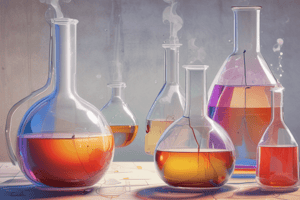Podcast
Questions and Answers
What does the leveling off of the curve in the graph indicate about the reaction over time?
What does the leveling off of the curve in the graph indicate about the reaction over time?
- The reaction is accelerating.
- The reaction is nearing completion. (correct)
- The reaction is becoming more exothermic.
- The reaction speed is constant.
How is the instantaneous rate of reaction at 2 minutes calculated?
How is the instantaneous rate of reaction at 2 minutes calculated?
- By drawing a vertical line at 2 minutes.
- By measuring the area under the curve.
- By calculating the average rate from 0 to 2 minutes.
- By finding the slope of the tangent to the curve at that point. (correct)
Which factor is NOT mentioned as affecting reaction rates?
Which factor is NOT mentioned as affecting reaction rates?
- Pressure (correct)
- Nature of reactants
- Concentration
- Temperature
What is the effect of smaller particle size on reaction rates?
What is the effect of smaller particle size on reaction rates?
Which type of bonds generally leads to faster reactions?
Which type of bonds generally leads to faster reactions?
What is a potential hazard of using finely divided particles in reactions?
What is a potential hazard of using finely divided particles in reactions?
What does the slope of a tangent line represent in the context of reaction rates?
What does the slope of a tangent line represent in the context of reaction rates?
Why do powdered chemicals tend to react more quickly than larger pieces?
Why do powdered chemicals tend to react more quickly than larger pieces?
What is the correct definition of the rate of a chemical reaction?
What is the correct definition of the rate of a chemical reaction?
Why do sodium chloride and silver nitrate react almost instantaneously when mixed in aqueous solution?
Why do sodium chloride and silver nitrate react almost instantaneously when mixed in aqueous solution?
How does increasing the pressure affect the rate of reaction between hydrogen gas and nitrogen gas?
How does increasing the pressure affect the rate of reaction between hydrogen gas and nitrogen gas?
What would you observe if you plotted the reciprocals of the times against the concentrations of sodium thiosulfate?
What would you observe if you plotted the reciprocals of the times against the concentrations of sodium thiosulfate?
In an exothermic reaction, what does the activation energy (EA) represent?
In an exothermic reaction, what does the activation energy (EA) represent?
What is the role of catalysts in a catalytic converter?
What is the role of catalysts in a catalytic converter?
Which condition is NOT needed for a dust explosion to occur?
Which condition is NOT needed for a dust explosion to occur?
What happens during the desorption stage of the catalytic conversion process?
What happens during the desorption stage of the catalytic conversion process?
Which of the following is a common catalyst poison?
Which of the following is a common catalyst poison?
What effect does an increase in the concentration of reactants have on the rate of reaction?
What effect does an increase in the concentration of reactants have on the rate of reaction?
What is required for a collision between particles to be effective?
What is required for a collision between particles to be effective?
What is the correct relationship between temperature and the rate of reaction?
What is the correct relationship between temperature and the rate of reaction?
Which product results from the reaction of carbon monoxide in a catalytic converter?
Which product results from the reaction of carbon monoxide in a catalytic converter?
If the initial concentration of sodium thiosulfate is 0.1 M, what is the concentration after diluting it to 60 cm³ with water?
If the initial concentration of sodium thiosulfate is 0.1 M, what is the concentration after diluting it to 60 cm³ with water?
Why do catalytic converters need to be changed after approximately 80,000 Km?
Why do catalytic converters need to be changed after approximately 80,000 Km?
What is the method to calculate the rate of reaction from the time taken for the cross to disappear?
What is the method to calculate the rate of reaction from the time taken for the cross to disappear?
What is the expected conclusion from a graph plotting reaction rate (1/t) against concentration of sodium thiosulfate?
What is the expected conclusion from a graph plotting reaction rate (1/t) against concentration of sodium thiosulfate?
What is an effective collision?
What is an effective collision?
What role do the precious metals like Platinum and Palladium play in a catalytic converter?
What role do the precious metals like Platinum and Palladium play in a catalytic converter?
Which of the following steps is NOT part of the mandatory experiment with sodium thiosulfate and hydrochloric acid?
Which of the following steps is NOT part of the mandatory experiment with sodium thiosulfate and hydrochloric acid?
What happens when sodium thiosulfate concentration is decreased during the experiment?
What happens when sodium thiosulfate concentration is decreased during the experiment?
What is the primary role of a catalyst in a chemical reaction?
What is the primary role of a catalyst in a chemical reaction?
What defines heterogenous catalysis?
What defines heterogenous catalysis?
In the example of the iodine snake experiment, which component acts as the catalyst?
In the example of the iodine snake experiment, which component acts as the catalyst?
What occurs during autocatalysis?
What occurs during autocatalysis?
How does a catalyst accelerate a reaction through the intermediate formation theory?
How does a catalyst accelerate a reaction through the intermediate formation theory?
What is a common issue that can arise with catalysts, such as in catalytic converters?
What is a common issue that can arise with catalysts, such as in catalytic converters?
What occurs during the surface adsorption theory in heterogenous catalysis?
What occurs during the surface adsorption theory in heterogenous catalysis?
Which statement is true about the effect of increasing the amount of catalyst?
Which statement is true about the effect of increasing the amount of catalyst?
What is the definition of Activation Energy?
What is the definition of Activation Energy?
What does a Reaction Profile Diagram illustrate?
What does a Reaction Profile Diagram illustrate?
How does a catalyst affect the Activation Energy of a reaction?
How does a catalyst affect the Activation Energy of a reaction?
What typically happens to the rate of reaction as the temperature increases?
What typically happens to the rate of reaction as the temperature increases?
What observable change occurs in the conical flask during the reaction between sodium thiosulfate and hydrochloric acid?
What observable change occurs in the conical flask during the reaction between sodium thiosulfate and hydrochloric acid?
If the concentration of sodium thiosulfate is halved, what effect does this have on reaction times?
If the concentration of sodium thiosulfate is halved, what effect does this have on reaction times?
Which of the following best explains the term 'rate of reaction'?
Which of the following best explains the term 'rate of reaction'?
What effect does increasing temperature generally have on particle collisions?
What effect does increasing temperature generally have on particle collisions?
Flashcards
Reaction rate
Reaction rate
The speed at which a chemical reaction occurs.
Instantaneous rate
Instantaneous rate
The rate of a reaction at a specific point in time.
Factors affecting reaction rate
Factors affecting reaction rate
Several aspects influence how quickly a reaction happens.
Nature of reactants
Nature of reactants
Signup and view all the flashcards
Particle size
Particle size
Signup and view all the flashcards
Concentration
Concentration
Signup and view all the flashcards
Temperature
Temperature
Signup and view all the flashcards
Catalyst
Catalyst
Signup and view all the flashcards
Catalytic converter
Catalytic converter
Signup and view all the flashcards
Catalyst poisoning
Catalyst poisoning
Signup and view all the flashcards
Effective collision
Effective collision
Signup and view all the flashcards
Activation energy
Activation energy
Signup and view all the flashcards
Adsorption
Adsorption
Signup and view all the flashcards
Desorption
Desorption
Signup and view all the flashcards
How does a catalytic converter work?
How does a catalytic converter work?
Signup and view all the flashcards
Homogenous Catalysis
Homogenous Catalysis
Signup and view all the flashcards
Heterogenous Catalysis
Heterogenous Catalysis
Signup and view all the flashcards
Autocatalysis
Autocatalysis
Signup and view all the flashcards
Intermediate Formation Theory
Intermediate Formation Theory
Signup and view all the flashcards
Surface Adsorption Theory
Surface Adsorption Theory
Signup and view all the flashcards
What happens to a catalyst's amount during a reaction?
What happens to a catalyst's amount during a reaction?
Signup and view all the flashcards
What is the effect of a catalyst on equilibrium?
What is the effect of a catalyst on equilibrium?
Signup and view all the flashcards
Reaction Profile Diagram
Reaction Profile Diagram
Signup and view all the flashcards
What does a catalyst do on a reaction profile diagram?
What does a catalyst do on a reaction profile diagram?
Signup and view all the flashcards
How does temperature affect reaction rate?
How does temperature affect reaction rate?
Signup and view all the flashcards
What does a reaction profile diagram show about a catalyst?
What does a reaction profile diagram show about a catalyst?
Signup and view all the flashcards
Relate rate to concentration
Relate rate to concentration
Signup and view all the flashcards
How to measure reaction rate
How to measure reaction rate
Signup and view all the flashcards
How do you find the reaction time?
How do you find the reaction time?
Signup and view all the flashcards
Rate of reaction
Rate of reaction
Signup and view all the flashcards
Why NaCl and AgNO3 react instantly?
Why NaCl and AgNO3 react instantly?
Signup and view all the flashcards
Increasing reaction rate
Increasing reaction rate
Signup and view all the flashcards
Measuring reaction time
Measuring reaction time
Signup and view all the flashcards
Rate's dependence on concentration
Rate's dependence on concentration
Signup and view all the flashcards
Dust explosion conditions
Dust explosion conditions
Signup and view all the flashcards
Higher concentration, faster reaction
Higher concentration, faster reaction
Signup and view all the flashcards
Temperature effect on reaction rate
Temperature effect on reaction rate
Signup and view all the flashcards
Sodium thiosulfate reaction experiment
Sodium thiosulfate reaction experiment
Signup and view all the flashcards
Graphing reaction rate
Graphing reaction rate
Signup and view all the flashcards
Conclusion from the graph
Conclusion from the graph
Signup and view all the flashcards
Understanding the relationship
Understanding the relationship
Signup and view all the flashcards
Study Notes
Rates of Reactions
- Chemists use the term "rate of reaction" to describe how quickly chemical changes occur.
- The rate of reaction is defined as the change in concentration per unit time of any one reactant or product.
Mandatory Experiment: Monitoring the Rate of Oxygen Production from Hydrogen Peroxide
-
Materials: 5 cm³ of hydrogen peroxide, diluted to 50 cm³ water, 0.5g manganese(IV) oxide, conical flask, small test tube, thread, stopper, graduated cylinder, delivery tube, beehive shelf, teat pipette, stop clock
-
Procedure:
- Measure and dilute hydrogen peroxide. Put in conical flask.
- Weigh and suspend manganese(IV) oxide in the flask. Avoid contact between the two.
- Fill a graduated cylinder with water and invert it over a beehive shelf. Fill the cylinder with air until the water level reaches 10 cm³.
- Position the delivery tube of oxygen to allow it to collect in the cylinder.
- Start the stop clock when the manganese oxide contacts the hydrogen peroxide by shaking the flask vigorously.
- Record the total volume of oxygen in the cylinder every 30 seconds.
-
Data Table: (Time (mins), Volume O₂ (cm³))
-
Analysis: Graph total volume of oxygen against time.
Instantaneous Rate of Reaction
- The instantaneous rate of reaction is the rate of reaction at any one particular time during the reaction.
Factors affecting Rates of Reactions
-
Nature of Reactants:
- The type of bonds involved (ionic or covalent), influences the difficulty to break these bonds before a reaction occurs.
- Ionic bonds are fast, whereas covalent bonds are slower.
-
Particle Size: Smaller particles have a higher surface area and collide more frequently, leading to faster reactions. Finely divided substances react more quickly than large pieces.
- Dust explosions can occur from finely divided particles. Conditions for dust explosions include: combustible particles, a source of ignition, dry particles, and oxygen presence.
-
Concentration: Higher concentrations of reactants lead to faster reaction rates because more particles mean more frequent collisions.
-
Temperature: Increasing the temperature increases the number of collisions and collision energy, resulting in a faster reaction rate. There's an exponential relationship between temperature and rate.
Catalysts
- Definition: A catalyst is a substance that alters the rate of a reaction but is not consumed in the reaction.
- Catalysts work in specific ways, functioning in small quantities, but not changing the overall reaction rate when there's an increase in the amount of the catalyst.
- General Properties: Catalysts: They participate in reactions, are recovered chemically unchanged afterward, are specific to reactions, and need a very small amount to function. Catalysts may be poisoned by substances e.g., lead. A catalyst speeds up the rate of equilibrium.
- Types of Catalysts:
- Homogenous catalysis: Both reactants and the catalyst are in the same phase (e.g., iodine snake experiment).
- Heterogenous catalysis: Reactants and catalyst are in different phases (e.g., oxidation of Methanol to Methanal).
Autocatalysis
- Autocatalysis is a type of catalysis in which one of the products of the reaction acts as a catalyst for the reaction.
Mechanism of Catalysis
- Intermediate Formation Theory: A catalyst forms an intermediate compound which is crucial in the decomposition reaction, for example, the decomposition of hydrogen peroxide catalyzed by I⁻ ions.
- Surface Adsorption Theory: Molecules accumulate on the surface, which leads to collisions that break and form new bonds initiating a reaction.
Catalytic Converters
- A catalytic converter is a device in a vehicle's exhaust system that converts harmful pollutants in exhaust gases to less harmful substances using catalysts like platinum, palladium, and rhodium.
Collision Theory and Activation Energy
- Effective collisions occur when particles collide with enough energy to overcome the activation energy (minimum energy required for reaction).
- Activation energy is the minimum energy needed for a reaction to occur.
- The size of the activation energy depends on the nature of the reactants.
Reaction Profile Diagrams
- Reaction profile diagrams show the change in energy during a reaction.
- Endothermic reactions absorb energy, the reactants have less energy than the products.
- Exothermic reactions release energy, the reactants have more energy than the products.
- Catalysts reduce the activation energy for a reaction.
Studying That Suits You
Use AI to generate personalized quizzes and flashcards to suit your learning preferences.
Related Documents
Description
This quiz covers the concept of rates of reactions in chemistry, focusing on an experiment to monitor oxygen production from hydrogen peroxide using manganese(IV) oxide. Students will learn essential laboratory techniques and understand the factors affecting reaction rates.




